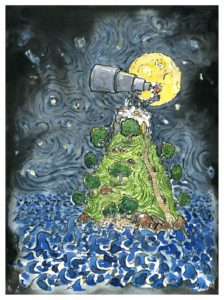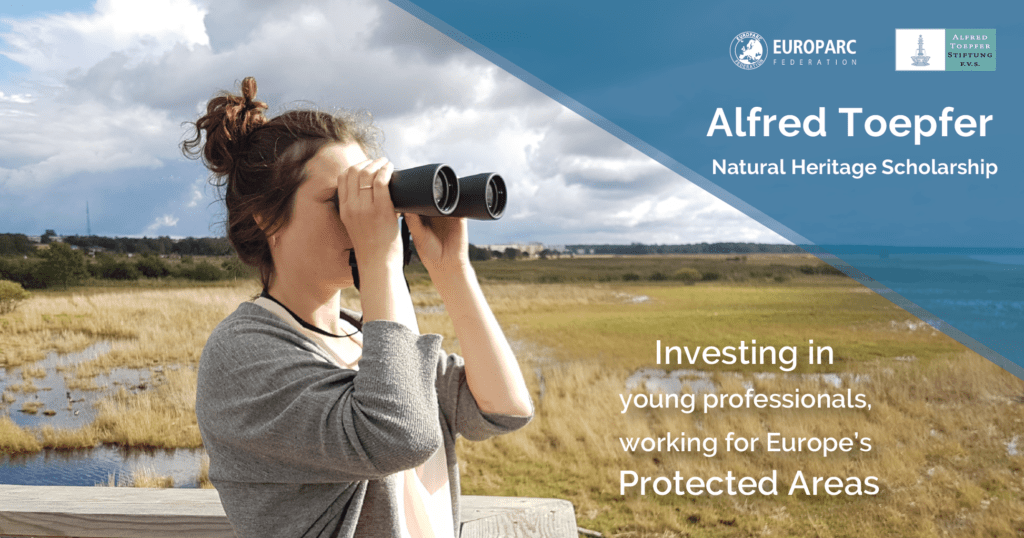An ideal for change by Marina Silva
Marina Silva is one of the invited contributors of the Protected Areas In-Sight 2017. Marina was Minister of Environment in Brazil between 2003-2008 and is currently running for President. During her mandate, 25 million hectares of new National Parks were created and over 12 million young people were involved in environmental actions all over the country. Follow Marina Silva on Facebook.
An ideal for change
article issued by Marina Silva
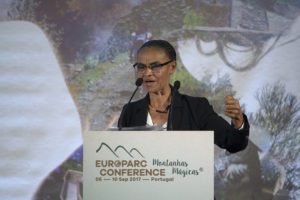
Marina Silva, environmental activist and member of the Brazilian Parliament was a keynote speaker at EUROPARC Conference 2017, Arouca, Magic Mountains, Portugal © Eduardo Realinho
A political crisis is visible around the world .The “owners of the world”, including authoritarian and/or populist leaders, seem more dedicated to profit from the crisis, instead of solving it. Big countries’ societies look for ways out but they seem to be stuck on how to change, remaining vulnerable to conscience numbness. Disorientation dominates.
This is just the most visible and noticed aspect of the situation, the tip of the iceberg. In reality, the crisis is much bigger and not restricted to conflicts of political and social nature, nor to the financial breakage that sweeps national economies in all continents, throwing billions of people into unemployment. The fast evolution of global warming and its terrible effects on the planet is extremely serious.
On the background of the political and social conflicts, there is a value crisis– a loss of meaning and a weakening of human solidarity.
Those crisis (political, social, economic, environmental and of values) are simultaneous because they are systemic. They form what I call civilization crisis. It is the human civilization who is at stake. For the first time in history, we need to face the possibility of an imminent interruption of conditions that allow life in this planet.
When success means failure
How did we come to this extreme condition? Paradoxically, it was not by failure, scarcity or weakness, but rather by our successes, by the excess and by the strength we impose on this planet. We obtained success with our technologies – on food production, disease treatment, recycling and waste management and, above all, in generating and using energy efficiently.
With these technologies, we grew abruptly: currently 7 billion with perspective of reaching 9 billion in 2050. We repeated the success formula and obtained more excess. We broadened the system that we started about 450 years with the arising of mercantilism, with its production and consumption model that does not account for the support capacity of ecosystems. Meanwhile, we are contaminating the atmosphere with gases causing temperature rise, destroying forests, landscapes, biodiversity, fertile soil and hydric resources at an unimaginable scale.
Yet more, the ultimate consequences is the change on human mentality and on the identity ideals that used to reference human endeavours.
In four centuries, the ideal of being was replaced by the ideal of having. Consumption started to be a symbol of success and achievement.
To have, or not to have?
We do not want to be immortal, as the Egyptian desired, nor wise and free, as the Greek wanted, or neither great and strong, as the Romans praised. We do not want to be saints or knights, as the medieval Europeans wanted. Now, we want to have, and to own things.
The meaning has inverted: before, being virtuous opened the possibility of earning valuable things; now, having valuable things may give us the means to be respectable, admirable and virtuous people.
We can “be” infinite things without exhausting the planet. However, in order to “have” more, we collide with natural boundaries. In four centuries, we crossed those boundaries and won our struggle against nature restrictions… And by doing that, we destroyed the source of life. We walk towards collapse.
How to overcome the civilization crisis?
I believe this is only possible if, within the crisis system, a significant amount of people unleash an identity-breaking pressure from the current system. World change will not come by a prolonged and reasonable planned transition, nor by a quick, abrupt and violent rupture. The old dilemma “reform vs. revolution” has expired.
Change can come from a type of alternative enabling mutation. It shall change mentalities, values, meanings, and ideals. And then, it will also change the way we produce, consume, and relate to each other and to other forms of life.
There will be no place in the world for excessive consumption. The planet cannot supply our infinite desire of having things, but our planet is the best environment there is for us to exercise our infinite wish for being. Of being the best artists, poets, writers, cooks, educators, physicians, people.
It is necessary to add to the great ideals of the French Revolution of equality, freedom and fraternity, the ethical imperative of sustainability.
LIFE Programme: simplified process and 2018 deadlines
One week ago, the European Commission announced a simplification to the LIFE Environment programme applications. The first of a two-stage application is to submit a concise concept note, with approximately 10 pages long. Applicants that make it through to the second stage of LIFE’s Environment sub-programme will then submit their full proposal based on feedback from the LIFE programme.
However, for the LIFE Climate Action sub-programme, the submission procedure remains unchanged. Applicants will submit full proposals from the start.14 February 2018.
Two-stage application for LIFE Environment sub-programme
for more information visit the EU Commission website
Stage 1: Concept Note
Applicants will be requested to submit a concept note in English that is approximately 10 pages long. The information that will be requested will notably include:
- Basic information about the coordinating beneficiary
- The environmental problem targeted (for environment and information & governance strands) / description of species, habitats, biodiversity issues targeted by the project (for nature and biodiversity strands)
- Project objectives
- The project partners (information on the coordinating and associated beneficiaries, and co-financers of the project)
- Actions and means
- Expected results and impacts of the project
- The sustainability of project results
- Project risks and constraints
- The EU added value of the project (understood at this stage as the contribution to LIFE priorities and objectives)
- The pilot or demonstration character of the project (and/or best practice for nature and biodiversity strand)
- An indicative budget for the project
All concept notes will be evaluated against two criteria:
- Overall quality of the proposal
- Overall EU added value
They will then be ranked by merit. Applicants with the best ranked concept notes will be invited to stage 2: submission of their full proposal.
For more information on the evaluation criteria please refer to the Multiannual Work Programme. Please note that the evaluation and application guides will be published on the day the call opens.
Stage 2: Full proposal
While there will be small adjustments to the full proposal forms, the information requested will not differ substantially from what has been requested in past calls for LIFE funding. You may wish to consult previous call documents for further guidance on the kind of information to provide. However, please bear in mind that only information published in the Guidelines for Applicants 2018 will be binding. As in past years, it will be possible to submit a full (stage 2) proposal in any official EU language, except Irish or Maltese. We nonetheless encourage applicants to submit their proposal in English.
Advantages for applicants
- The submission of a concept note that is approximately 10 pages long requires less time and fewer resources than a full proposal (in case of the application is unsuccessful)
- Applicants will receive feedback sooner on whether their proposal has a chance to be financed (has been admitted to stage 2)
- Applicants invited to participate in stage 2 will have a higher chance of seeing their projects financed, as the competition will be open only to high ranking concept notes
Indicative timetable
| Indicative timetable | |
|---|---|
| Date or period | Activity |
| mid-April 2018 | Call publication |
| 12 June 2018 (tbc) | Deadline for applicants to submit concept notes to the Contracting Authority |
| October 2018 (tbc) | Applicant notification, invitation of shortlisted applicants to submit their full proposal |
| January 2019 (tbc) | Deadline to submit full proposals |
| January 2018 to June 2019 (tbc) | Evaluation and revision of proposals |
| July 2019 (tbc) | Signature of individual grant agreements |
| 1 July 2019 (tbc) | Earliest possible starting date |
Nature conservation management of wet grasslands, by Baiba Galniece
Matsalu National Park, Estonia - photo by Baiba Galniece, winner of the Alfred Toepfer Natural Heritage Scholarship in 2016
Nature conservation management of wet grasslands
Issued by Baiba Galniece
Every year, the Alfred Toepfer Natural Heritage Scholarship (ATS) supports the work of young conservationist in protected areas across Europe. Baiba was one of the winners of the Scholarship in 2016. She works for the Environmental Conservation Agency in Latvia and with the Scholarship visited 4 protected Areas – 2 in Hungary and other 2 in Estonia.
Applications for the 2018 Natural Heritage Scholarship edition are now open! Get to know how to apply.
Floodplain grasslands play an important role in the context of climate change mitigation and adaption and they serve different ecosystem services such as flood protection, water purification, nutrient and water retention and, of course, food production.
However, these habitats are strongly threatened by human activities. This is very important for Eastern and Central Europe where many examples from the last decennium have shown a shift in flooding periods from winter to summer which generates more severe consequences. Therefore, nature-based approaches need to be taken into account where restoration of floodplain functions, safety and habitat creation are combined together.
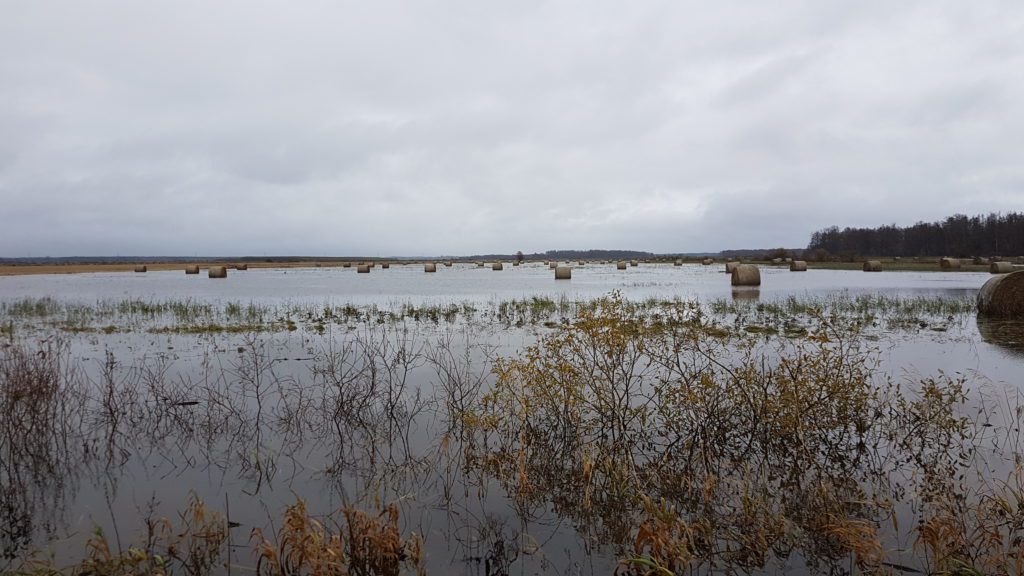
photo by Baiba Galniece
The above mentioned issue – a shift in flooding periods from winter to summer floods due to climate change – seems to appear more frequently among Latvia’s rivers and therefore there is an urgent need for projects with nature-based approaches for climate change mitigation and adaption, and projects with sustainable long-term effect on nature conservation.
The aim of the study was to visit several protected areas in Estonia and Hungary where large-scale projects on floodplain grassland restoration have been realised, to see how these areas are managed after the end of the project. I collected and compared examples how project sites on grasslands are managed and monitored, and how these data are used in decision-making for nature conservation in both countries.
In Hungary, I visited the Őrség National Park and Balaton Uplands National Park, whilst in Estonia, I visited Matsalu National Park and Sooma National Park.
To be able to reach the aim and objective of this study, several activities were implemented:
- visits of the protected areas’ headquarters;
- field trips on grasslands areas;
- discussions with experts about protected area administration, management plans, operational plans, grassland management practice and monitoring, available agri-environmental programme, collaboration with landowners, implemented projects;
- presentations about nature protection and conservation in Latvia.
Outcomes of the study
At the end of the study tours, I have collected different examples about wet grassland management practices – the main techniques and methods that are used in grassland management according to different biodiversity targets (plant, bird, butterfly species etc.). Also information on monitoring system and evaluation mechanism of the effectiveness of grassland management practice. Moreover, the linkage of grassland management and agri-environmental programmes was explored.
main findings in Hungary…
- 1) Mowing time and frequency has changed (mowing once and mostly in May)
- 2) Low willingness to participate in the agri-environmental subsidy programme
- 3) Cannot influence grassland management on private land
- 4) Due to lack of management, abandoned grasslands are infected by alien species
- 5) Every grassland has a yearly management plan
- 6) In Balaton, a large scale wetland restoration work runned for over 30 years, to combine flood prevention and nature conservation and water buffalos are used as grazers
main findings in Estonia…
- EU funds enabledNature conservation management of grasslands to be initiated
- Land managers are interested to join agri-environmental programme, which definitely has helped to maintain biodiversity in their grasslands
- Good cooperation with Estonia’s State Forests
- Problem: a solution is needed to start using collected hay in reels, on the margins of fields
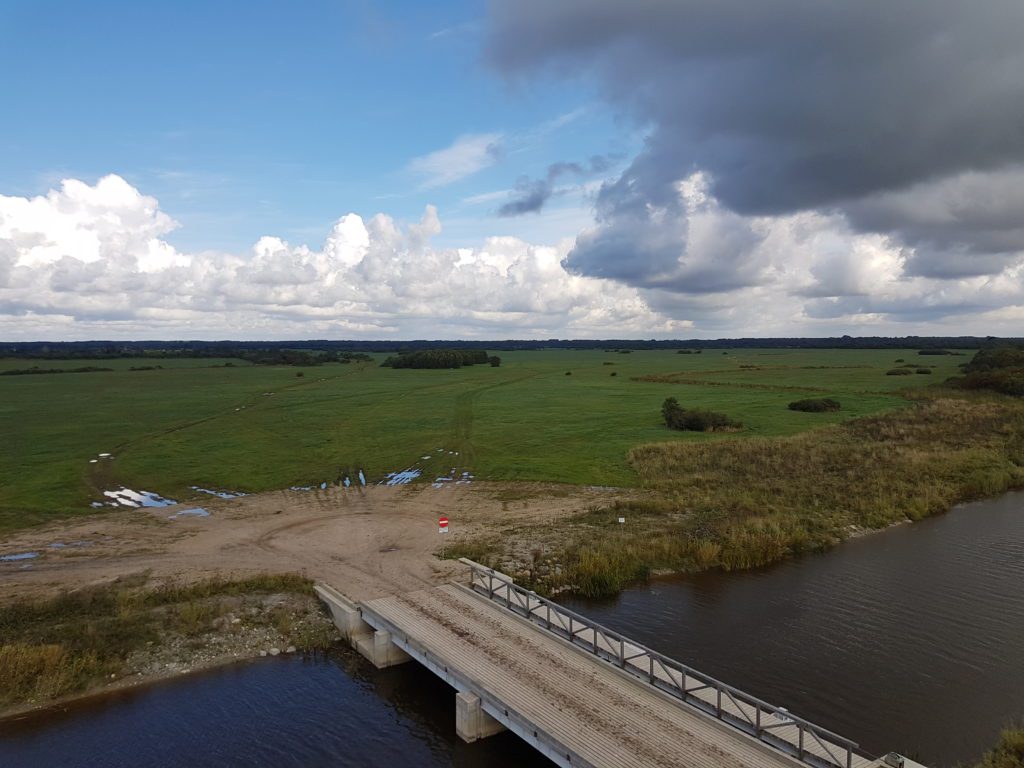
During the study, I broadened not only my practical and professional experience, but it also benefited to my personal development.
For more detailed information, download the full report here.
Protected Areas In-Sight 2017
The Journal of the EUROPARC Federation is out!
In this Protected Areas In-Sight 2017, we bring you a sweet memory of EUROPARC Conference 2017 in the Portuguese “Magic Mountains”. There, with an interesting panel of keynote speakers, we explored some of the new values needed for nature and people, looked at the new visions emerging worldwide, and identified the new voices for preserving Europe’s natural heritage.
The journal is available in English, German and French. If you would like to receive a printed copy, please write us to b.pais @ europarc.org.
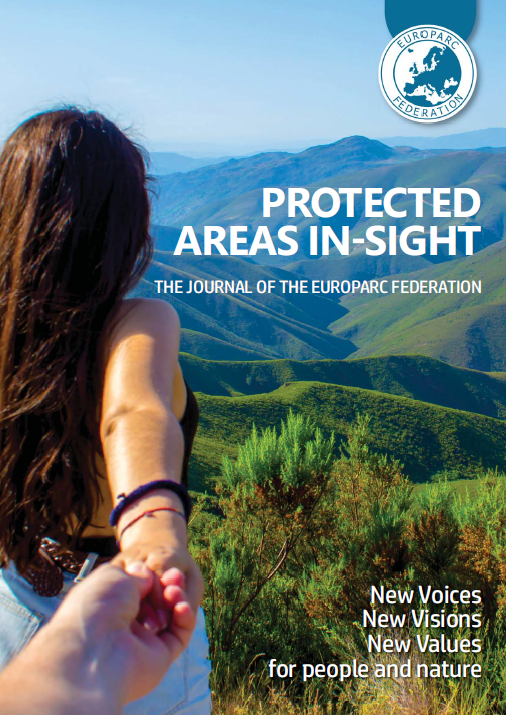
IMPACT Interreg Europe: Special edition
How to implement new management models to promote sustainability in and around parks? Experiences and outcomes coming from the IMPACT Interreg Europe project partners are shared in this special edition.
Protected Areas have proven to be a stimulus for economic development, thus preventing current rural abandonment. That’s exactly what Junta de Andalucia is doing since 1989 in this Spanish region. Meanwhile, from Lithuania, in order to diminish conflicts between people with different interests, new mangement systems were created – were stakeholders involvement is essential.

Overtourism
With the United Nations declaring 2017 as the International Year of Sustainable Tourism for Development, and with tourism in Parks growing as never seen before, we compiled a special section to help you better manage tourism flows in your Protected Area. Tips and ideas from EUROPARC network can be found in the special section “Overtourism”.
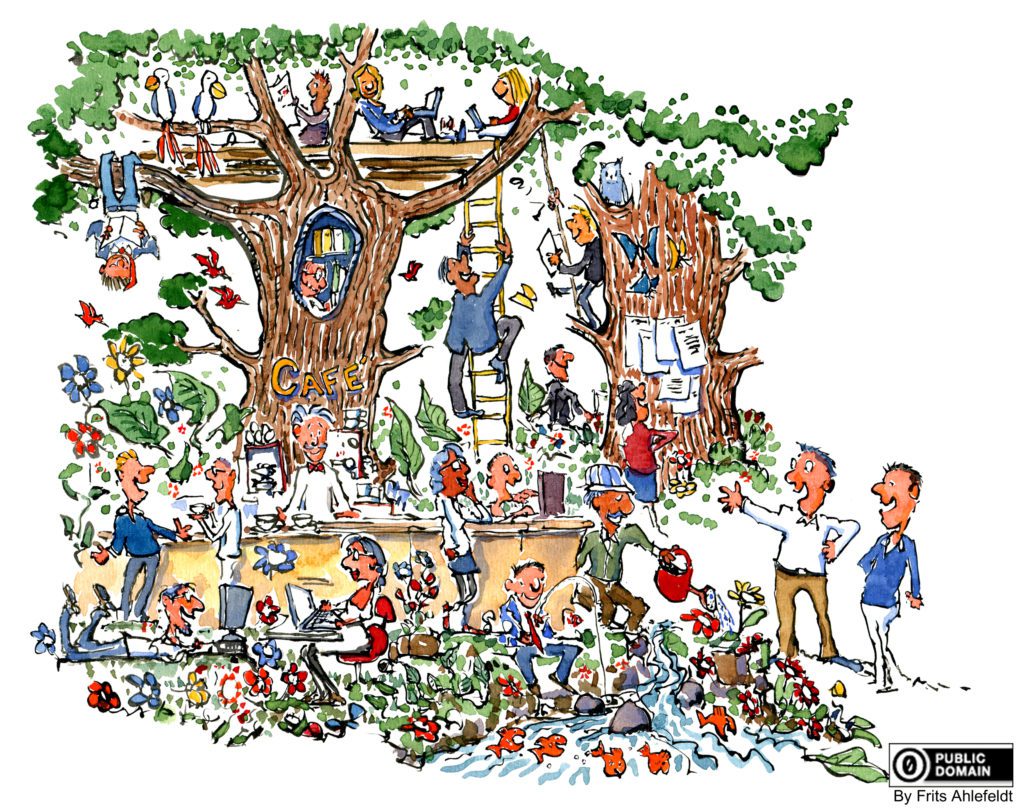
Illustration by Frits Ahlefeldt www.fritsahlefeldt.com or www.hikingartist.com
